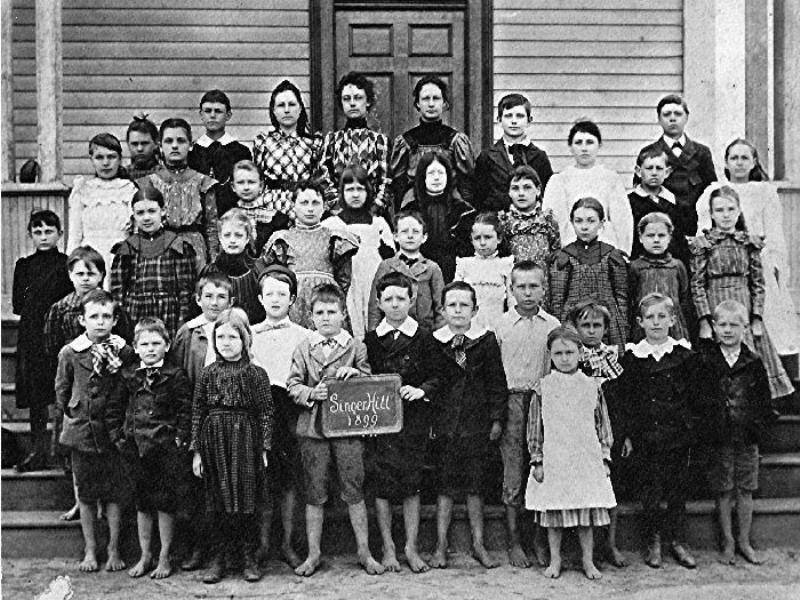
Schoolwear Hosiery: Barefeet

Figure 1.--This photo was taken at Singer Hill School in 1899. The school was located in
Cambria County, Pennsylvania. We see children both barefoot and wearing long stockings. The children wearing shoes are all wearing long stiockings. Bare legs were acceptable only for children coming to school barefoot. .
|
|
While not a hosiery type, barefeet was a hosiery option. Here there are two basic options. The first and most common was chilrren who came to school barefoot without footwear of any kind. This was common in the 19th and early-20th century. And is still common in many developing countries. The second is children who came to school with footwear, but no socks. This commonly meant wearing sandals. In some countries (England, New Zealand, and South Africa) this was part of the unifom at individual schools. We also see children wearing shoes without socks, this was most common with sneakers. This seems most common with teenagers during warm weather. Mothers often insisted that younger children wear hoisiery of some kind. There were also gender diffeences. Girls more commonly wore shoes without socks, often strap shoes.
Without Footwear
We notice chilrren who came to school barefoot without footwear of any kind. This was common in the 19th and early-20th century. And is still common in many developing countries. Children of course who went barefoot obviously did not wear hosiery. We note children commonly coming to school barefoot in the 19th and early 20th century, although thi varied significantly from country to country. Here climate was a major factor. Shoes and socks weee ibviously needed in northern countries, although even here soime children went brefoot in sime countries. We see a lot of Scottish children coming to school barefoot, although the cottish climate was milder than that of Scabdinavia or Russia. Here poverty was a major factor. This was not always the case. We notice children in some countries that obviously come from families that could afford shoes, coming to school barefoot. This was the case in America until World War II and is still the case in South Africa and New Zealand. One hosiery trend was that children could have bare legs only if they came to school brefoot. If they wore shoes they had to wear long stockings. This was a very common convention, for example, in America until after World War I. Children in developing countries also came to school barefoot, but for the most part we do not see extenive public school systems until after World War II.
We notice children who came to school with footwear, but no socks. This commonly meant wearing sandals. We see sandals appering after the turn-of-the 20th century. Popularity varied from country to country. Sandals were not very common in Amerixa during the 20th century, but wre in England and other European sandls. We see many English boys wearing school sandals, although they declined in popularity as snekers became more popular. There we diffeent styles of sandals. Before World War II we generally see closed-toe sandals. Open-toe (often called Roman sndals) became more popular in the late-20th century. Closed-toe sadals were often worn with socks, although we see this choice varying seasonally. Also countries had varrying popular conventions about hosiery and sandals. Open-toe sandals were often worn without socks. In some countries (England, New Zealand, and South Africa) this was part of the unifom at individual schools. We also see children wearing shoes without socks, this was most common with sneakers. This seems most common with teenagers during warm weather. Mothers often insisted that younger children wear hoisiery of some kind. There were also gender diffeences. Girls more commonly wore shoes without socks, inckuding strap shoes, pumps, and sneakers.
HBC-SU

Related Chronolgy Pages in the Boys' Historical Web Site
[Main Chronology Page]
[The 1900s]
[The 1910s]
[The 1920s]
[The 1930s]
[The 1940s]
[The 1950s]
[The 1960s]
[The 1970s]
[The 1980s]
[The 1990s]
[The 2000s]
Navigate the Relate Boys Historical Clothing School Uniform Garment Pages
[Return to the Main school hosiery types page]
[Main garment page]
[Blazers]
[Bookbag]
[Caps]
[Coats]
[Kilts]
[Pants]
[Shirts]
[Shoes]
[Smocks
[Suits]
[Seaters]
[Ties]
Navigate the Boys' Historical Clothing School Uniform Country Pages
[Main School Uniform Page]
[Main National School Uniform Page]
[Australia]
[England]
[France]
[Germany]
[Ireland]
[Italy]
[Japan]
[New Zealand]
[Poland]
[Singapore]
[Scotland]
[Singapore]
[United States]
Navigate the Boys' Historical Clothing Web Page
[Introduction]
[Activities]
[Biographies]
[Chronology]
[Clothing styles]
[Countries]
[Bibliographies]
[Contributions]
[FAQs]
[Glossary]
[Images]
[Links]
[Registration]
[Tools]
[Boys' Clothing Home]
Created: 9:28 AM 3/30/2012
Last updated: 11:56 PM 3/30/2012




